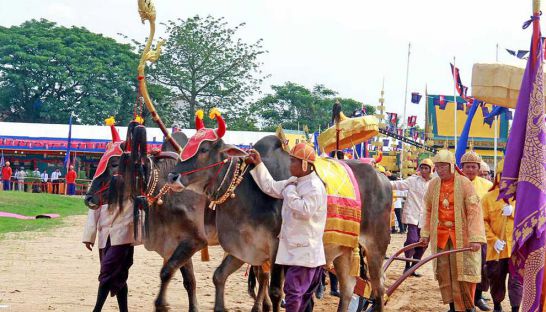Bumper year for beans, corn: Ox
Bumper year for beans, corn: Ox
The Royal Ploughing Ceremony, held yesterday in Battambang province, has forecast a promising outlook for the production of beans and corn in the coming year, although observers say that much still depends on the weather.

The ceremony, conducted under the presence of King Sihamoni, marks the beginning of the agricultural production and rainy season.
The royal oxen, which are tasked with predicting the forthcoming harvest, chose to eat beans and corn this year.
“As per the ancient forecast, using the seven types of crops consumed by the royal oxen, this year bean production will be better, corn production will also be better,” said the palace’s chief fortuneteller Kang Ken during the ceremony.
The oxen are presented with seven bowls containing paddy rice, sesame, grass, water, corn, beans and white wine.
It is believed that if they choose rice, corn, sesame or beans it represents a good harvest for that produce, but eating grass or drinking the liquids could lead to disease or disaster.
The oxen refused to eat any rice, the Kingdom’s largest agricultural commodity, leading to concerns about production levels for next year.
But Hean Vann Horn, deputy director general of the General Directorate of Agriculture, remained optimistic about the prospects of rice production.
“Corn and beans are hard to grow and produce less output than paddy rice. So if the traditional forecast says that the production of the two crops will get a good result, there is no need to be concerned about rice production,” Horn said.
“Royal forecasts, so far, have always been correct. There were some deviations, as these days we are talking about climate change. It is a global effect,” he added.
Some farmers, however, remain sceptical of the traditional forecast.
Nem Noun, a rice farmer in Battambang province, said that from his personal observations in the past few years the results of the forecast were usually the opposite of what is eventually produced.
“Previous years, every time the oxen touched paddy rice, the paddy rice got disease,” he said. “Last year, the royal oxen ate rice, as you can see, rice production decreased. This year, I expect a better result.”
Royal oxen eat offerings of corn and beans during the annual royal ploughing ceremony in Battambang province yesterday avoid rice all together. AFP
Yang Sophal, a bean and corn farmer with 30 hectares of cultivation area in Pailin province, said she wasn’t convinced by this year’s predictions.
“It is totally depends on the rainfall, as there is no water source near our farm. The heat usually goes down in May, but the rain has just started a few days ago and the heat is still strong, as it was in April,” Sophal said.
“I am worried that this year, there will not be enough rain like last year,” she added.
According to the Ministry of Agriculture’s annual report, a prolonged dry spell last year affected close to 200,000 hectares of the crop, with about 20,300 hectares of paddy rice completely damaged, the most damage to the rice crop since 2010.
Expecting better weather conditions this year, the Ministry of Agriculture is predicting a three per cent increase in rice production for the 2015-2016 season.
The Ministry of Water Resource and Metrology issued a letter on May 2 predicting average rainfall for May and June, with heavier rain expected from July to October.













